Christopher Gill
cgill@schools.nyc.gov
Newcomers High School
28-01 41st Ave
Long Island City, N.Y. 11101
Grade/Subject: 11th Grade United States History and Government, 12th Grade Participation in Government, Advanced Placement United States Government and Politics
| About the Grant: |
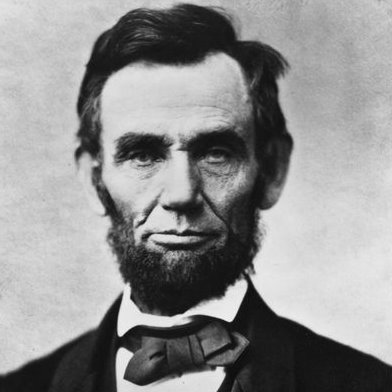
The Lincoln's Legacy- Then and Now project/unit will focus students on researching and studying specific events during Lincoln 's lifetime and
how he was perceived by the public. I find that many students (and Americans) have a historically inaccurate view of the Presidency of Abraham Lincoln. This unit will
attempt to bring out the misconceptions we all share about President Lincoln and his legacy. This project/unit will help students learn in great detail about some of the
criticisms and endorsements that President Lincoln faced before, during and after his presidency.
The first lesson will informally
“test” the students about their knowledge of history and presidential administrations. The students will decide who they think the top three presidents are/where
based on three pieces of evidence/proof. Students will show what previous knowledge they come to class with and any ideas or possible misconceptions they may have about
presidents. They will compare their own decisions and rankings with the C-SPAN 2009 Historians Presidential Leadership Survey, and decide how their opinions matched up with
scholars and historians.
The second lesson will serve to show what historic or cultural knowledge students have of Abraham Lincoln. This lesson will also discuss some of the less
than cordial views of the Washington administration and its handling of foreign affairs. The students will also learn the definition of public opinion and relate it to the
current Obama administration.
The final assessment will be a primary document based power point presentation. Students will work in groups of 4 to research specific documents/speeches
from Abraham Lincoln's candidacy and presidency and the various public attitudes towards Lincoln at the time. Groups will do research in computer labs and will prepare their
presentations on a SMART Board or overhead projector. The power point presentations must be engaging and utilize specific primary documents which show different view points
of Lincoln . Groups will present their documents and findings to their fellow classmates and must follow specific instructions in order to receive full credit.
How it Works:
First students will learn about the many historic and cultural misconceptions related to the Lincoln Presidency. Students will learn about public opinion and the importance
of public opinion during any administration, as well as how we rank our past presidents today. Students will also research how decisions made by the president of the United
States of America are viewed by the American people and how public opinion of presidents changes over time.
Upon researching how the public viewed Presidential Candidate Lincoln and President Lincoln during his lifetime, students will learn how public opinion in the United States
constantly evolves through time. Students will also realize that hindsight and historic knowledge of the results of presidents' decisions change our contemporary views of
many past presidents. Our modern attitudes of President Lincoln vary greatly with the views and opinions of Lincoln before, during, and after his time in office. Students
will learn that if public opinion regarding President Lincoln has changed significantly through generations, it may also become true of any of our modern presidents who
have been greatly scrutinized by the public.
Final Project/Product:
The culminating assessment at the end of the project/unit will help the students perform their own research in order to learn about the spectrum of public opinion during
the Lincoln administration. Students will use primary documents associated with President Lincoln as well as political cartoons, essays, letters, newspaper articles, editorials
etc, to show the many faces of public opinion concerning the Lincoln administration. This assessment project will also show the students, through their own research, that
our modern attitudes towards President Lincoln have evolved greatly. Students will understand the various positions of public opinion during the Lincoln administration,
whether they be in support of the president or condemning his actions.
Overall Value:
Students will come away with a greater understanding of the struggles that President Lincoln faced, as well as an appreciation for the constantly changing face of public
attitudes towards past presidents. I also strive to have my students understand that although many Americans today feel that he was one of our greatest presidents, public
opinion of Lincoln 's actions has changed a great deal through history.
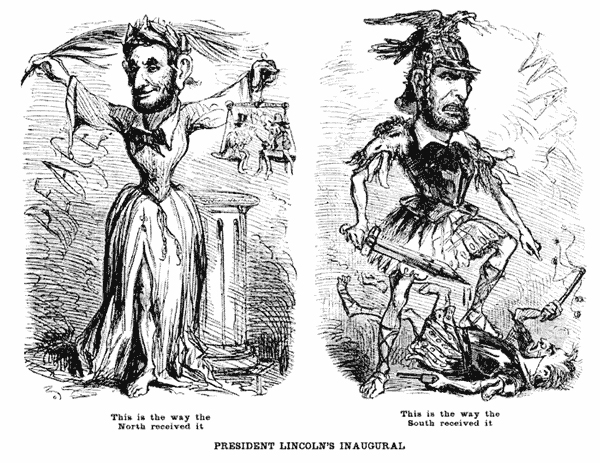
The political actions of the United States government or the president may face great battles in the realm of public opinion today, but public opinion and perception may
also change with time. |
|
|
| How This Grant was Adapted: |
This project/unit would work well with senior classes like Participation in Government, Advanced Placement United States History, Advanced Placement United
States Government and Politics or any government or American history electives. There are several reasons why I would adapt or use this project/unit with upperclassmen.
First, it would help if the students had already learned about sectionalism, the Civil War, and Reconstruction the year before during United States History and Government.
Second, the students will need to have previous knowledge about the Constitution and the powers of the president in order to fully utilize this type of unit. This project/unit
would also be helpful to use with seniors because they should have better research skills, as well as computer and internet expertise in order to complete their research.
Seniors should also be preparing to write papers and create presentations on a higher level in order to prepare for college.
This unit could be adapted or used by a United States History and Government teachers and classes, but I would be concerned with the amount of time a project like this
may take to prep for. We must always consider if our students need more scaffolding during the research or presentation phases of the project. Juniors will also have limited
knowledge of presidential administrations after Abraham Lincoln, which could minimize the overall goal of the project/unit.
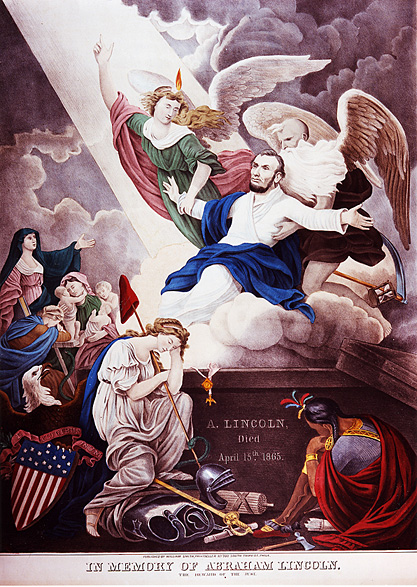
|
|
|
| Project URL |
|
|
|
| Objectives |
Objectives:
- Students will have an overall understanding of public opinion and its relationship to the presidency.
- Students will understand common social and cultural misconceptions related to past presidential administrations.
- Students will learn how public opinion and attitudes towards presidents has and can change throughout history.
- Students will have a deeper appreciation for the failures, accomplishments and struggles of President Abraham Lincoln.
- Students will learn how to use relevant internet resources to research specific historic events and documents.
- Students will analyze various forms of primary documents for historical context, bias and opinion.
- Students will learn how to create interactive and engaging group power point presentations using primary documents and historical evidence.
- Students will utilize their historic knowledge and research to relate public opinion during the Lincoln Presidency to our most recent presidents.
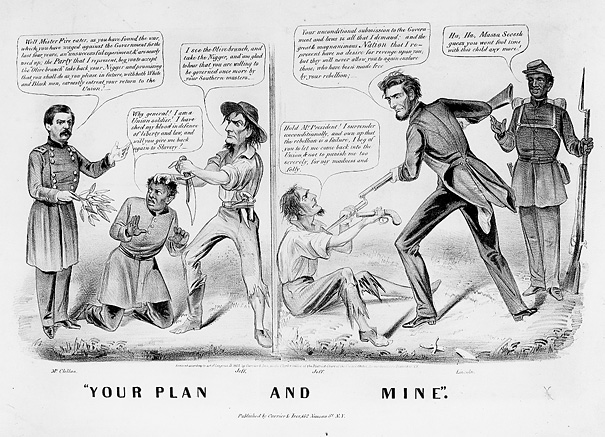
|
|
|
| Websites Used |
- http://c-span.org/PresidentialSurvey/Overall-Ranking.aspx
C-SPAN 2009 Historians Presidential Leadership Survey.
- http://c-span.org/Series/Lincoln-200-Years.aspx
February 12, 2009 marked the 200th anniversary of Abraham Lincoln's birth. In observation of this milestone, C-SPAN, through their own original productions, takes
you to the places that defined the man, his presidency
& our nation. Everything you need to know, learn or find about Lincoln can be found here or linked from this site.
- http://quod.lib.umich.edu/l/lincoln
An online version of Roy P. Basler's eight-volume edition of The Collected Works of Abraham Lincoln , which was published between 1953 – 1955.
- http://historynow.org/12_2005/interactive.html
The Gilder Lehrman Institute of American History- Interactive History of Lincoln through the media.
- http://lincoln.lib.niu.edu
Northern Illinois University in cooperation with the University of Chicago, the Newberry Library, the Chicago Historical Society, Illinois State University, The Illinois
State Archives, Lewis University, and Knox College. Contains campaign music and video interviews with leading historians, as well as extensive primary resource texts,
over 1,500 images and maps, and other resources. Lincoln/Net presents historical materials from Abraham Lincoln's Illinois years (1830-1861), including Lincoln's writings
and speeches, as well as other materials illuminating antebellum Illinois.
- http://digitalhistory.uh.edu/reconstruction/index.html
This exhibit examines one of the most turbulent and controversial eras in American history. It presents an up-to-date portrait of a period whose unrealized goals of
economic and racial justice still confront our society. The text is by Eric Foner, the DeWitt Clinton Professor of History at Columbia University, and Olivia Mahoney,
Director of Historical Documentation at the Chicago Historical Society.
- http://memory.loc.gov/ammem/alhtml/alhome.html
Mr. Lincoln's Virtual Library highlights two collections at the Library of Congress that illuminate the life of Abraham Lincoln (1809-1865), the sixteenth
president of the United States. The Abraham Lincoln Papers housed in the Manuscript Division contain approximately 20,000 items including correspondence and papers
accumulated primarily during Lincoln's presidency. Transcriptions and annotations for the Papers are available through a cooperative agreement with the Lincoln
Studies Center, Knox College. The "We'll Sing to Abe Our Song!" online collection, drawn from the Alfred Whital Stern Collection in the Rare Book and Special
Collections Division, includes more than two hundred sheet-music compositions that represent Lincoln and the war as reflected in popular music. In addition to the sheet
music, the Stern Collection contains books, pamphlets, broadsides, autograph letters, prints, cartoons, maps, drawings, and other memorabilia adding up to over 10,500
items that offer a unique view of Lincoln's life and times. Mr. Lincoln's Virtual Library provides access to a variety of documents and resources about Abraham
Lincoln.
- http://digitalhistory.uh.edu/ahd/civilwar.html
The development of this online exhibit was sponsored by the Gilder Lehrman Institute of American History. This exhibit is based on the book, A House Divided: America
in the Age of Lincoln , by Eric Foner and Olivia Mahoney.
- http://valley.lib.virginia.edu
The Valley Project details the life in two American communities, one Northern and one Southern, from the time of John Brown's Raid through the era of Reconstruction.
- http://home.att.net/~rjnorton/Lincoln80.html
Lincoln links

|
|
|
| Standards Addressed: |
All of the following standards are for Social Studies Secondary Education students in New York State.
Standard 1 - History of the United States and New York
- analyze the development of American culture, explaining how ideas, values, beliefs, and traditions have changed over time and how they unite all Americans
- describe the evolution of American democratic values and beliefs as expressed in the Declaration of Independence, the New York State Constitution, the United States
Constitution, the Bill of Rights, and other important historical documents
- discuss several schemes for periodizing the history of New York State and the United States
- develop and test hypotheses about important events, eras, or issues in New York State and United States history, setting clear and valid criteria for judging the importance
and significance of these events, eras, or issues
- compare and contrast the experiences of different groups in the United States
- examine how the Constitution, United States law, and the rights of citizenship provide a major unifying factor in bringing together Americans from diverse roots and
traditions
- compare and contrast the experiences of different ethnic, national, and religious groups, including Native American Indians, in the United States, explaining their
contributions to American society and culture
- research and analyze the major themes and developments in New York State and United States history (e.g., colonization and settlement; Revolution and New National
Period; immigration; expansion and reform era; Civil War and Reconstruction; The American labor movement; Great Depression; World Wars; contemporary United States)
- prepare essays and oral reports about the important social, political, economic, scientific, technological, and cultural developments, issues, and events from New
York State and United States history
- analyze historical narratives about key events in New York State and United States history to identify the facts and evaluate the authors' perspectives
- consider different historians' analyses of the same event or development in United States history to understand how different viewpoints and/or frames of reference
influence historical interpretations
- evaluate the validity and credibility of historical interpretations of important events or issues in New York State or United States history, revising these interpretations
as new information is learned and other interpretations are developed. (Adapted from National Standards for United States History)
Standard 4 - Economics
- identify, locate, and evaluate economic information from standard reference works, newspapers, periodicals, computer databases, monographs, textbooks, government publications,
and other primary and secondary sources
Standard 5 - Civics, Citizenship, and Government
- explain how the Constitutions of New York State and the United States and the Bill of Rights are the basis for democratic values in the United States
- understand the basic civil values that are the foundation of American constitutional democracy
- know what the United States Constitution is and why it is important (Adapted from The National Standards for Civics and Government, 1994)
- understand that the United States Constitution and the Constitution of the State of New York are written plans for organizing the functions of government
- understand how citizenship includes the exercise of certain personal responsibilities, including voting, considering the rights and interests of others, behaving in
a civil manner, and accepting responsibility for the consequences of one's actions (Adapted from The National Standards for Civics and Government, 1994)
- analyze issues at the local, state, and national levels and prescribe responses that promote the public interest or general welfare, such as planning and carrying
out a voter registration campaign
- describe how citizenship is defined by the Constitution and important laws
- explore how citizens influence public policy in a representative democracy
- explain how democratic principles have been used in resolving an issue or problem
All of the following standards are for English Language Arts Secondary Education students in New York State.
Standard 1
Students will read, write, listen, and speak for information and understanding.
As listeners and readers, students will collect data, facts, and ideas, discover relationships, concepts, and generalizations; and use knowledge generated from oral, written,
and electronically produced texts. As speakers and writers, they will use oral and written language to acquire, interpret, apply, and transmit information.
Standard 2
Students will read, write, listen, and speak for literary response and expression.
Students will read and listen to oral, written and electronically produced texts and performances, relate texts and performances to their own lives, and develop an understanding
of the diverse social, historical, and cultural dimensions the texts and performances represent. As speakers and writers, students will use oral and written language for
self-expression and artistic creation.
Standard 3
Students will read, write, listen, and speak for critical analysis and evaluation.
As listeners and readers, students will analyze experiences, ideas, information, and issues presented by others using a variety of established criteria. As speakers and
writers, they will present, in oral and written language and from a variety of perspectives, their opinions and judgments on experiences, ideas, information and issues.
Standard 4
Students will read, write, listen, and speak for social interaction.
Students will use oral and written language for effective social communication with a wide variety of people. As readers and listeners, they will use the social communications
of others to enrich their understanding of people and their views.
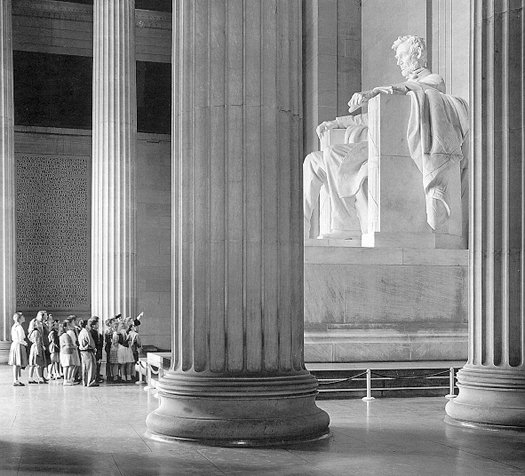
|
|
|
| Lesson 1: |
The Greatest President of the United States
Project Objectives:
- Students will use previous knowledge of American history and presidential administrations to create a list of the three top presidents of the United
States.
- Students will research, discuss, argue and debate the merits of their favorite American presidents.
- Students will understand how C-SPAN's 2009 Historians Survey of Presidential Leadership, compares with their ideas and reasoning behind their list.
Materials:
- laptop computer with internet access
- SMART Board/ projector
- blackboard/whiteboard with chalk/markers
- Web Design Template
Procedures:
- Teacher will write AIM and DO NOW on the board. AIM - How can we decide who the greatest presidents
are/were? DO NOW - Take out your notebook, work with your partner and write down some standards/rules for selecting the greatest presidents of the United
States of America.
- Teacher will give students about 10 minutes to complete the DO NOW . Teacher will circulate around the room asking questions, answering questions
and engaging students in completing their assignment.
- After 10 minutes groups will share out their standards/rules for selecting the greatest American presidents. As each group shares their standards/rules teacher will
use the Web Design Template on the overhead or board. The teacher will give each pair a marker/piece of chalk to write their ideas on the on the whiteboard/blackboard/overhead.
- Upon completion of the Wed Design Template students will decide on the most important standards/rules to use in analyzing the success/failures of
various American presidents.
- Teacher will inform students that they have 20 minutes to choose what they think the 3 greatest presidents were. Students may work in pairs and use all classroom resources,
but they must follow the standards/rules they created. Each pair must also have at least 3 historically accurate reasons why each president they selected can be considered
great.
- Teacher will circulate around the room asking questions, answering questions and engaging students in completing their assignment.
- After 20 minutes pairs will share out their presidents and 3 historic reasons behind their chosen presidents. After a list of presidents is made the students will
analyze the list with their standards/rules that they created during the DO NOW .
- Students will debate, argue, and discuss which presidents should be in the top 3 and which order they should come in based on their standards/rules. After this classroom
discussion time the teacher will hold an election to see who the top 3 presidents are. After selecting 3 presidents to be in the final round the students will once again
vote for the order each president will place in.
- Teacher will then use the laptop (with internet connection) and projector/SMART Board to show students Link 1: http://c-span.org/PresidentialSurvey/Overall-Ranking.aspx, which is C-SPAN's 2009 Historians Presidential Leadership Survey. Students will see how their
list compares with the list created by C-SPAN in 2009. Teacher will also encourage students to find other presidents mentioned or not mentioned in class on the C-SPAN
list. Teacher will also show the students the links under Individual Leadership Characteristics to show the students the standards/rules the historians
voted by. Students will compare their system to the presidential historians system and decide which is better and why.
- Students will answer AIM in their notebooks. Students and teacher will have a classroom discussion about if students had any ideas or opinions changed
during class. Students will decide how accurate/inaccurate their system was.
Homework:
Presidential Greatness Interview: Ask five people who they think the three top presidents are/where. Ask them for 3 specific examples to support their
opinions. Write down the results of each interview and answer the following questions for each interviewee.
- Do you think this individual have solid historic reasoning behind his/her answers?
- Was the interviewee knowledgeable about this topic?
- What are some of your conclusions about the interviewee's ideas and opinions?
Assessment:
- Students engage in cooperative learning
- Students engage in several classroom discussions and debates
- Students create their own system of selecting the greatest presidents
- Students research historic events, people and places to rank presidents
- Students compare their classes' selection strategies with the strategies of
- C-SPAN's Historians Presidential Leadership Survey
- Students will complete interviews and written assignment for next class
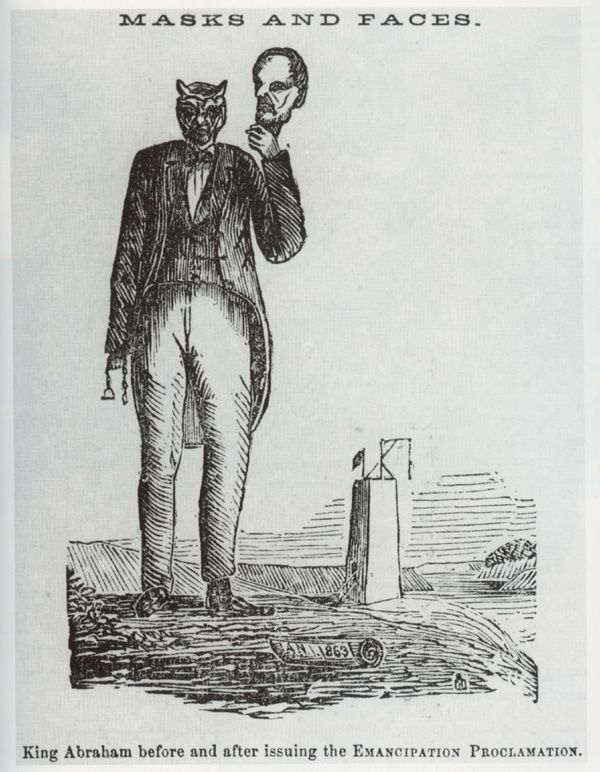
|
|
|
| Lesson 2: |
Presidential Public Opinion- here today - gone tomorrow?
Project Objectives:
- Students will discuss and understand the current social, political, and cultural characteristics of President Abraham Lincoln
- Students will understand that many Americans have misconceptions and preconceived notions about past presidents
- Students will learn the definition of public opinion
- Students will understand that public opinion about past presidents is changeable and may not reflect public opinion during the historical time period
- Students will understand and relate the possibilities of the changing face of public opinion with the current and recent administrations
Materials:
- blackboard/whiteboard –
chalk/markers
- Lincoln's Legacy Today Chart
- overhead projector/laptop with projector/SMART Board
- President Washington's Struggles
- Public Opinion in the Time of Lincoln Project
Procedures:
- Teacher will write AIM and DO NOW on the board. AIM- How and where do we see President Abraham
Lincoln's legacy in American society today? DO NOW- What does the word legacy mean? Give two examples of any legacies that you know about in your life.
- Students will have 5 minutes to answer the DO NOW . The class will then discuss what they think the definition of a legacy is and some examples of
legacies they are knowledgeable about (sports, music, family, religion, cultural etc.) Teacher should also collect homework during the DO NOW .
- Teacher will then briefly discuss last nights homework and the experiences the students had and the knowledge, or lack there of, of their interviewees. Teacher will
then hand out Lincoln's Legacy Today Chart and will circulate around the room asking questions, answering questions, and engaging students. Students
will have 15 minutes to fill in as much as they can in the Lincoln's Legacy Today Chart .
- Students will then pair up (different pairs from lesson 1, which will be chosen by the teacher) and share their answers. After a couple of minutes pairs will share
answers with the class and write their answers on the overhead projector/SMART Board with markers provided by the teacher. (hopefully the students will come up with
dozens of answers from historical information to pop culture references like: Presidents day vacation, the 5 dollar bill, the penny, the Lincoln Memorial, freeing the
slaves, winning the Civil War, commercials to sell products, the Emancipation Proclaimation/13 th Amendment, Reconstruction, reuniting the country, his beard, his top
hat, his assassination, his height, some of his famous speeches, learning how to read by candle light, the name of highways/roads/schools etc.)
- Class will discuss what the modern views of President Lincoln's legacy and how we see them everyday in our society and pop culture.
- Teacher will ask students if there are any other presidents who may have a similar legacy to President Lincoln. The students should answer President George Washington.
Class can briefly discuss his legacy and how popular he is today while the teacher hands out President Washington's Struggles reading/worksheet.
- Students will read President Washington's Struggles reading/worksheet, analyze the primary documents and answer the questions in full sentences.
- After about 15 minutes the teacher will go over the documents and questions with the students using the overhead projector/SMART Board/ or laptop and projector
- Teacher and students will discuss the term “public opinion” and what it means. Teacher will give students a few brief definitions to add to their own thoughts. Public
Opinion - a belief or sentiment shared by most people; the voice of the people. Public opinion is the aggregate of individual attitudes or
beliefs held by the adult population. Public opinion can also be defined as the complex collection of opinions of many different people and the sum of all their views
.
- Class will discuss how some views of President Washington's administration maybe unexpected. Teacher will facilitate a brief discussion on whether or not the students
feel Washington's legacy has changed since his administration. Teacher will ask the students if public opinion of Washington is different now then from when he was president.
Teacher will ask students if they think public opinion of President Lincoln is different now also. Teacher will ask the students how and hopefully the issue of sectionalism/the
Civil War will come up and the students will realize how half the country probably hated Lincoln from the start.
- Teacher will hand out Public Opinion in the Time of Lincoln Project and ask the students to review their project for homework.
- Teacher will discuss with students if they feel that the current and most recent administrations will have a legacy which may depart from the public opinion at the
time. Especially the Obama administration and the George W. Bush administration.
Homework:
Read and begin research for your Public Opinion in the Time of Lincoln Project .
Assessment:
- Students engage in cooperative learning
- Students engage in several classroom discussions and debates
- Students discuss and write about the legacy of President Lincoln
- Students analyze primary documents about President Washington
- Students read and write about President Washington's struggles in office
- Students use historical knowledge and current social and cultural views
- to compare and contrast different views of public opinion Today vs. yesterday
- Students use prior knowledge and recently attained knowledge to discuss public opinion and how it may change overtime
- Students analyze recent administrations and how they may or may not be remembered by the public
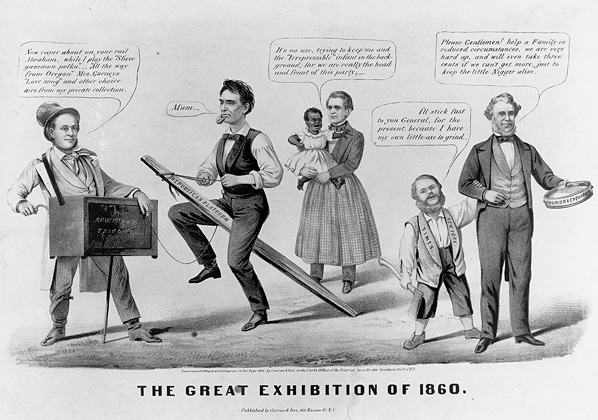
|
|
|
| Lesson 3: |
Lincoln in the Lab Part I- research, research, research
Project Objectives:
- Students will work in groups of four to begin research project
- Students will use computer labs to research and complete power point presentations
- Students will utilize various online historical libraries and databases to find relevant primary documents for their presentations
- Students will analyze primary documents for bias, opinion, symbolism and historical context
- Students will create informational and engaging power point presentations
Materials
- Computer lab with internet access or laptop carts for classroom use
- Predetermined groups of 4 for the students to work in
- Extra copies of Public Opinion in the Time of Lincoln Project
Procedures:
- Teacher will bring students to the schools computer lab, or bring in laptop carts to use in the classroom
- Teacher will write AIM and DO NOW on the board. AIM- How can we use historical libraries and databases to find historically
relevant documents? DO NOW- Sit together with your groups and take out your Public Opinion in the Time of Lincoln Project instructions.
- Teacher will read through the instructions with the students and ask if there are any questions. Students will get to work on their projects.
- Teacher will circulate around the lab/classroom checking in on each group and their progress.
- Students will assign their own group members specific jobs discussed in the instructions.
- Students will have to find a copy of their document through the given websites. Students will read the document and analyze it for historic information. Students should
also begin to think about how this document may have stirred up both positive and negative public opinion about Candidate or President Lincoln.
- After about half the period has gone by teacher will ask each group to come up one by one and show what progress is being made or what problems the group maybe facing.
- Students will work in groups and have to save and print out relevant information and documents before the end of the period.
Homework:
Continue working on your project. Be sure to follow your instructions and complete your own personal tasks for the benefit of yourself and your group!
Assessment:
- Students engage in cooperative learning
- Students utilize technology in the classroom
- Students use historical libraries and online databases for research
- Students must present documentation of group progress
- Students in each group are given specific tasks to complete
- Students must analyze primary documents and prove their historic relevance to their assignment
- Students must evaluate documents for negative and positive bias
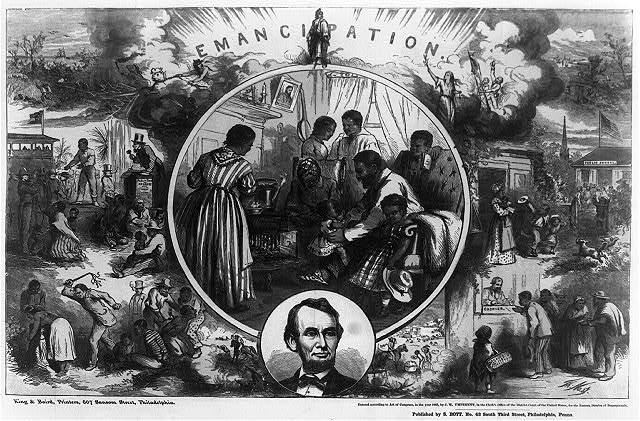
|
|
|
| Lesson 4 |
Lincoln in the Lab Part II- more research, more research, more research
Project Objectives:
- Students will work in groups of four to continue research project
- Students will use computer labs to research and complete power point presentations
- Students will utilize various online historical libraries and databases to find relevant primary documents for their presentations
- Students will analyze primary documents for bias, opinion, symbolism and historical context
- Students will create informational and engaging power point presentations
Materials
- Computer lab with internet access or laptop carts for classroom use
- Predetermined groups of 4 for the students to work in
- Extra copies of Public Opinion in the Time of Lincoln Project
Procedures
- Teacher will again bring students to the schools computer lab, or bring in laptop carts to use in the classroom
- Teacher will write AIM and DO NOW on the board. AIM- How can we use historical libraries and databases to find historically
relevant documents? DO NOW- Sit together with your groups and take out your Public Opinion in the Time of Lincoln Project instructions.
- Teacher will ask each group what problems they are experiencing with their research. Upon discussing all of the research problems, hopefully students will realize
that many groups are having similar problems and will be encouraged to help each other out. Teacher will also discuss the importance of the dates of the documents the
students are using in their project. They must use primary documents that fit the criteria in the instructions as well as have direct relevance to the Lincoln document
they were given to do the public opinion research on.
- Teacher will circulate around the lab/classroom checking in on each group and their progress.
- Students will continue with their specific jobs discussed in the instructions.
- After about half the period has gone by teacher will ask each group to come up one by one and show what progress is being made or what problems the group maybe facing.
Teacher will also ask about the historic relevance and context of the Lincoln document they are using for their project.
- Students will work in groups and have to save and print out relevant information and documents before the end of the period.
Homework:
Continue working on your project. Be sure to follow your instructions and complete your own personal tasks for the benefit of yourself and your group!
Assessment:
- Students engage in cooperative learning
- Students utilize technology in the classroom
- Students use historical libraries and online databases for research
- Students must present documentation of progress and understanding
- Students in each group are given specific tasks to complete
- Students must analyze primary documents and prove their historic relevance to their assignment
- Students must evaluate documents for negative and positive bias
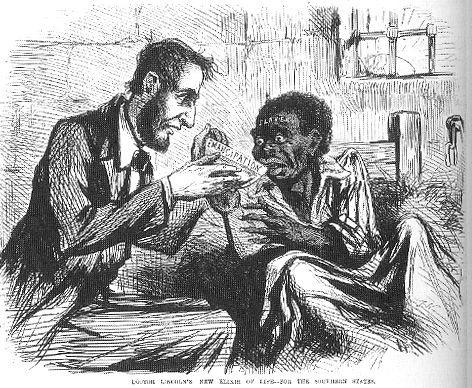
|
|
|
| Lesson 5: |
Lincoln's Legacy Lives - Group Presentations
Objectives:
- Students will present their power point presentations to the class
- Students will understand how public opinion during the Lincoln's lifetime varies greatly from what the American public perception is today
- Students will learn how Lincoln's actions or words helped drum up support or create more animosity towards his administration
Materials:
- Laptop with internet access and projector/ SMART Board
- Public Opinion Presentation Surveys
Procedures
- Teacher will write AIM and DO NOW on the board. AIM- How does public opinion about President Abraham
Lincoln during his lifetime differ from our public opinion of him today? DO NOW - Get into groups and be ready to present.
- Teacher will collect all hard copies of power point presentations. Each group must attach one copy of group instructions with the names and jobs of each group member
to the hard copy of the group power point.
- And because we all know how important public opinion is, the teacher will hand out Public Opinion Presentation Surveys and students will fill them
out during the presentations.
- Groups will be selected based on the date of their Lincoln document and presentations will begin.
Homework:
Guided Writing: Has Lincoln's legacy changed? How has it changed or not changed? What was public opinion like about President Lincoln during his administration
(give 5 examples)? What is public opinion like about President Lincoln today (give 5 examples)? What was the most interesting thing you learned about during this project?
Why?
Assessment:
- Students will present their projects
- Students will be using technology to present their projects to the class
- Students will be assessing each others presentations with surveys
- Students will compare and contrast public opinion of Lincoln today vs. during his lifetime
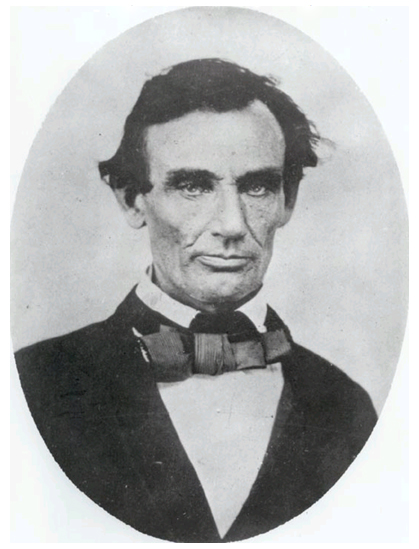
|
|
|
| Lesson 6: |
|
|
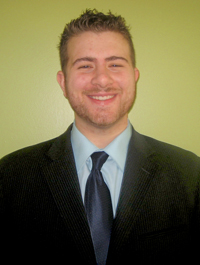
Christopher has been a member of the Social Studies Department at Newcomers High School and has served as an adjunct lecturer at LaGuardia Community College for the past four years.
He has taught United States History and Government, Participation in Government, Economics, AP United States Government and Politics, Critical Thinking: How We Elect Our Presidents
and Global Studies. As a first-generation American, Christopher is familiar with the struggles of ESL and bilingual students and has had many experiences with both populations in
both his professional and personal life. He strives to bring history alive to his students through various methods of assessment including role playing and acting as well as other
student-centered activities.
Wed Design Template - Graphic Organizer
Lincoln's Legacy Chart
President Washington's Struggles
Public Opinion in the Time of Lincoln Project
Public Opinion Survey Chart
|